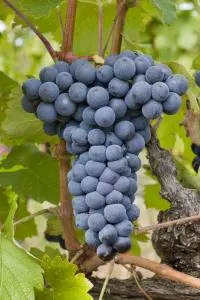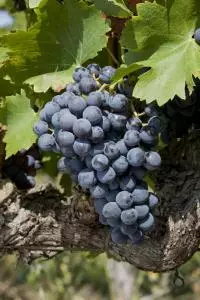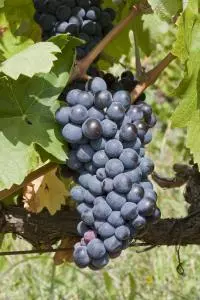
Syrah grape variety
Because of its pretty name, it was long believed to be Persian, Syrian or born in Syracuse. Recent analyzes have revealed that our beloved Syrah had in fact taken root in Savoie and Ardèche. A low-yielding, rare and precious grape variety, it is only grown in suitable and privileged areas. A southern variety, it has a spicy character and delicious notes of violet that it knows how to express in Rhône wines, which are as fine as they are complex.
Syrah is one of the most emblematic red grape varieties of the northern part of the Côtes du Rhône. Due to its rarity, it is only used to produce certain great wines. However, it is cultivated all over the world and flourishes on more than 140,000 ha around the world, from Argentina, South Africa, California to Chile, and from New Zealand to Mexico. In Australia it is famous as Shiraz.
Origin
Maturity
Maturité précoce
Location
All of the Rhône Valley - Single black grape variety for the red wines of the N…
Planted area
29.11% of the vineyards
- In the vineyards
- In the cellars
- Appellations
In the vineyards
Ampelography
Syrah produces pretty branches, fragile and cottony when young, and young green leaves. Adult, its leaf has five lobes.
Bunch and berries
Its clusters, with a distinctive elongated cylindrical shape, have small or medium berries, silky and deep purple.
Maturity
Early-ripening.
Characteristics
Quite vigorous grape variety, but which varies depending on the choice of clones and the method of pruning. Its branches require trellising.
Terroir
Cooler hillsides and terroirs.
In the cellars
Characteristics
Floral, peppery, structured: Syrah is an assertive grape variety. It produces colourful, aromatic, delicate yet robust wines. Tannic but not very acidic, its wines are therefore suitable for aging. It gracefully exudes, in reds, fruity (red and black fruits: raspberry, redcurrant, blueberry, blackberry) and floral (violet, mignonette), and even spicy (truffle, pepper, licorice, menthol) scents. It also gives rise to pretty fruity rosés. As it ages, its characteristic violet aroma evolves towards more complex notes where musk, truffle, leather, pepper or licorice mingle…
Wine styles
Still dry red and rosé wines.
Appellations
Côtes du Rhône Cru AOC Cairanne
Côtes du Rhône Cru AOC Beaumes-de-Venise
Côtes du Rhône Cru AOC Châteauneuf-du-Pape
AOC Châtillon-en-Diois
Côtes du Rhône Cru AOC Cornas
AOC Costières de Nîmes
Côtes du Rhône Cru AOC Côte-Rôtie
AOC Côtes du Rhône
AOC Côtes du Rhône Villages
AOC Côtes du Vivarais
Côtes du Rhône Cru AOC Crozes-Hermitage
AOC Duché d'Uzès
Côtes du Rhône Cru AOC Gigondas
AOC Grignan-les-Adhémar
Côtes du Rhône Cru AOC Hermitage
Côtes du Rhône Cru AOC Lirac
AOC Luberon
Côtes du Rhône Cru AOC Rasteau
AOC vin doux naturel Rasteau
Côtes du Rhône Cru AOC Saint-Joseph
Côtes du Rhône Cru AOC Tavel
Côtes du Rhône Cru AOC Vacqueyras
AOC Ventoux
Côtes du Rhône Cru AOC Vinsobres
What is an AOP?
This is the European equivalent of the AOC. It designates a product originating from a specific region or place and whose quality or characteristics derive from this geographical environment.
What is a single-varietal wine?
Single-varietal wines are rare in the Rhône Valley, but they do exist. These are wines made from a single grape variety. In the reds, Cornas wines are single-varietal, and in the Côte-Rôtie, Saint-Joseph, Hermitage and Crozes-Hermitage AOCs, both single-varietal and blends are accepted. For whites, the Condrieu and Château-Grillet AOCs are Viognier-based single-vine varieties. Each winemaker is free to make single-varietal wines with the grape variety of their choice, provided of course that it is one of the varieties authorised by the decree governing their appellation. Some appellations, by tradition as much as by choice, have positioned themselves in the production of single-varietal wines, while others cultivate the art of blending.
What is a blended wine?
To make a white, rosé or red wine, the producer can create a composition of several grape varieties (assemblage). A Grenache-Mourvèdre, for example, is a blended wine, as opposed to a 100% Syrah, which is a single-varietal wine. A single-varietal wine is not ‘better’ than a blended wine - nor vice versa. They are simply different. In the Rhône Valley, each appellation defines the possibility for producers to use one or more grape varieties (based on viticultural, historical and traditional criteria). We can also talk about blending when a producer composes a cuvée from several parcels or batches (this time without any connection with the notion of grape variety).
What is veraison?
Throughout July, the grape berries increased in volume and were enriched with organic acids. From mid-July onwards, in the earliest areas of the Rhône Valley, the grapes began to change colour - this is called veraison.
This phase can last from a few days to 2 or even 3 weeks, depending on the grape variety and climatic conditions. At this point, the growth of the shoots slows down, and the vine stops accumulating acids to concentrate on producing sugars, which is when ripening begins.
The appearance of the grapes changes from green to pink, then from blue-red to black for coloured grape varieties (the pigment is anthocyanin) and from green to translucent or yellowish for white grape varieties. It is in the skins that the components of the grape's colour and aromas are developed.
On the other hand, the pulp of the grapes begins to be enriched with sugars while still remaining very rich in acids.
Winegrowers pay particular attention to this stage in the development of the grape, as it is the first indication of the harvest date. It is estimated that the harvest begins around 30 days after mid-veraison, i.e. when half the berries have changed colour. This length of time may vary depending on the weather conditions at the time, but also on the winemaker's objectives, depending on the type of production. To make fresh white or rosé wines, i.e. to retain natural acidity, you can choose to harvest the grapes at the end of the harvest.
What are tannins?
Tannins are part of the polyphenol family. These powerful antioxidants, which are beneficial to human health, also play a protective role in wine. And, of course, they give red wine its structure and body.
Red wines are less fragile than whites, thanks to their tannins! These compounds act as oxygen traps, protecting their aromas and colour from premature ageing.
Where do tannins come from?
Mainly in grape skins. They are also found in seeds, wood (tann means oak in Breton, and tan is powdered oak bark used to tan leather), tea, chocolate, etc. The richness of the tannins depends on the grape variety (Tannat from the South-West is aptly named) and the way in which the vineyards are tended. The vinification process then seeks to extract the wine's full potential. Ageing then enhances and stabilises what has been extracted. The addition of oxygen, wood, temperature and length of vatting all help to shape the final tannins.
How do tannins taste on the palate?
When taking a sip of wine, the taster perceives gustatory sensations on the tongue (sweetness, for example), and others that are tactile, such as the astringency of the tannins, perceived on the inside of the cheeks. This information is sent to the same area of the brain, which leads to confusion, particularly when we associate the sensations of sweetness and soft tannins. The vocabulary refers to the feel of a fabric: professionals speak of coarse, fine, tight, firm, silky tannins...
Before tasting, what do I see and smell?
First of all, it's important to pay attention to how the wine looks and smells. Your sense of sight and smell will give you plenty of information to help you enjoy the tasting.
Intensity. The intensity of a wine can refer to its colour. It can be pale, light, strong or dark. It can be deep and sometimes very dark. Sommeliers generally refer to a wine's colour. During a tasting, the eye is the first sense to be used. This observation can provide information about the age and style of the wine, among other things.
Legs and tears. These are the marks left on the rim of the glass when the wine is swirled. As a general rule, the greater the alcohol and sugar content of the wine, the greater the number of tears and legs that form along the edge of the glass.
The nose. The aromas released when the wine is at rest constitute the first nose. Once the wine has been lightly stirred, the second nose appears, giving way to more pronounced aromas.
The aromas. Unlike flavours, which are perceived through taste, aromas are perceived through the nose. There are over 500 different aromas in wine. Primary aromas are directly linked to the type of grape varieties used. Secondary aromas come from fermentation. Tertiary aromas appear depending on the ageing method used (in vats or barrels).
How do you enjoy it?
Once the visual and olfactory aspects have been analysed, it's time to explore by tasting the wine. This last stage is the final assessment. Not everyone has the same perception, and that's part of the art of tasting!
Toasting the wine. To begin the tasting and allow the wine to express itself fully, we toast it. You've probably heard that funny noise some people make when they take their first sip? Wine is said to be toasted. This consists of letting air into the mouth to aerate it.
Flavours. Flavours include bitterness, saltiness, sweetness and acidity. For example, to determine the acidity of a wine, we use the following words: flat, soft, fresh for the least acidic, or lively, nervous, biting and aggressive for the most acidic. Generally speaking, we judge a wine according to its balance.
Tannins. These are contained in the grape skins and seeds. A wine high in tannins dries out the tongue and sometimes even the palate. Tannins can be fine, silky and velvety, or coarse and rough. Cyril Del Moro adds that ‘When a wine is tannic, we can also use the term “robust” to describe it’.
Length. A wine can be more or less persistent on the palate. This length is both aromatic and gustatory. It's at the end of the mouth that you realise how long a wine is. Cyril Del Moro, for his part, is fond of the Caudalie term: ‘This old term refers to the length in the mouth.
Should I decant my wine?
Decanting a wine is something that should be done with great care, as there is a risk of damaging a great wine. Wine can be decanted either to decant it or to aerate it. The two processes are quite distinct and are considered for two very different types of wine.
How do you decant a wine?
Old wines are decanted. After several years in the cellar, a wine produces deposits. Before tasting, you may wish to rid it of these impurities. Removing this deposit is called decanting. The wine should be poured carefully into a narrow decanter. Be careful not to pour your wine too quickly or for too long before tasting it. If the wine is exposed to air, it could lose all its structure and the complexity of its aromas, which have been developed over time.
A little tip for decanting: pour your bottle in front of a candle! Against the light, it will be easy to stop in time before the wine particles fall into the decanter.
How to decant to aerate?
Decanting a wine means oxygenating and aerating it. We recommend using a decanter with a flared neck and a wide base, to give the wine a certain amplitude and greater contact with the air.
As Caroline Bougier, sommelier at the Wine Bar in Nîmes, explains, oxygen ‘will awaken the wine, reveal its aromas and help it to develop its full potential’. Aeration can be done more or less quickly, either by opening a bottle a few hours before drinking, or by decanting the wine to speed up the process.
Young wines, especially reds, are generally decanted, but some white wines also benefit from decanting. Caroline Bougier particularly recommends decanting vintage wines. ‘Decanting will reveal all the aromatic richness of Syrah, Mouvèdre or Carignan grapes’.
A young wine is less delicate than an old wine. It's easy to handle and pour into the decanter. There are several oxygenation techniques available to you, with varying degrees of speed: either swirl the wine vigorously in the decanter, pour it into a carafe and leave it to rest for a while, or aerate it as if you were serving mint tea.
Discover other black grape varieties
Discover the other black grape varieties of the Rhône Valley.







